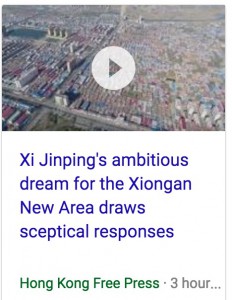From Paul Romer interview with Cloud Yip from iMoney magazine:
Q: The idea of Charter Cities originated from Hong Kong and Shenzhen, am I right?
Romer: The two most interesting precedents for Charter Cities are Hong Kong and Shenzhen, so it does have some origins here. They each played important roles in fostering reform of the Chinese economy. But it is an approach that can be used in any country that wants to implement reforms, even a developed country like the United States. It turns out that this is a unique time in human history when it is possible t
o start many new cities because there is an enormous, unmet demand for city life.
Shenzhen was China’s first Special Economic Zone, opening to foreign investment and free enterprise in 1980 under Deng Xiaoping. An earlier post (Brexit, Texit, Calexit, and the Future of China) looked at Shenzhen and Shanghai Pudong New Zone, China’s early open reforms designed to follow the success of Hong Kong.
These three regions are the freest and prosperous in China. Hong Kong is considered the freest economy in the world (Hong Kong story about Heritage Economic Freedom Index, and here is story of Fraser Inst. Economic Freedom of the World Index).
And now China has opened a new Special Economic Zone, “China’s new special economic zone brings back memories of Shenzhen“:
Special Economic Zone aren’t automatic. Some succeed and residents prosper, while others don’t. Lotta Moberg notes in “The political economy of special economic zones,” (Journal of Institutional Economics):
Policy makers introducing SEZs must overcome the knowledge problem to avoid misdirected economic planning. Yet, the scheme can only fulfill its purpose if it also prevents destructive rent-seeking behavior, both from businesses and from government authorities. The political economy framework of SEZs can be applied to judge their potential efficacy, something that orthodox studies of country features such as natural resources, infrastructure, and zone location fail to do. The Indian and Chinese experiences with SEZs illustrate these points.
“China’s new special economic zone brings back memories of Shenzhen,” (BusinessInsider, April 20, 2017) notes SEZ status raised Shenshen from a fishing village of 30,000 to today’s dynamic megacity with almost 12 million people:
The Xiongan New Area, which will eventually cover 2,000 square kilometers—more than twice the size of New York City—is intended to relieve congestion in the capital of Beijing and nearby Tianjin. Among other potential consequences include spreading the country’s economy northwest, away from the bustling coastal cities…
Like Shenzhen before it, Xiongan is expected to offer phenomenal investment opportunities. Remember, we’re talking about a brand new megacity literally built from the ground up. According to UBS estimates, the project will require as much as $580 billion over the next 20 years.
The South China Morning Post‘s page on Xiongon New Area SEZ is here.
Lotta Moberg’s page links to a variety of articles on Special Economic Zones, including “Is It Time That America Adopted Special Economic Zones?” (Daily Caller, March 30, 2017) which looks at SEZs as a way to counter current protectionist and nationalist trends in the U.S. and around the world:
How do you solve a problem like protectionism? With a U.S. president threatening a trade war, populism dominating political headlines in Europe, and decreasing popularity of trade deals, think-tankers and political pundits are scrambling for ways to escape a vicious circle towards ever-higher barriers to trade. Turning this development around may take a long time. In the mean time, though, countries may still create spaces where the barriers do not apply.
Read more: http://dailycaller.com/2017/03/30/is-it-time-that-america-adopted-special-economic-zones/#ixzz4f35qgdOP

